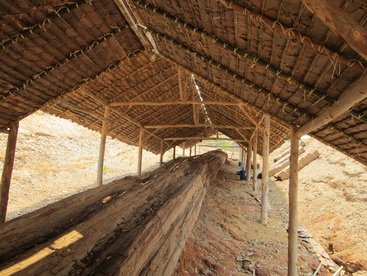Why is it important to protect these fossil trees?

These fossil trees are very important in terms of scientific value. They help us understand the diversity of ancient trees, paleobiogeography of plants, the climate and environment of the past, including geological changes through time.
“To know your future, you must learn from your past...” - Margaret Jang
The primary source of local income is derived from the sale of forest products such as herbs and plants growing at the top of trees, or locally available mushrooms which grow only after forest fires and heavy rains.
Many local people illegally cut the trees in the forest parks and burn parts of the forest to collect the herbs and fungi that grow on the trees. These illegal activities happen quite often and are detrimental to the ecosystem as a whole, and limit our ability to study and learn from the amazing fossils present.
Although educational programs have been initiated to reduce illegal logging and harvesting from the forest, a reach out program, engaging all local people has not been taken. Using these unique fossil trees as an icon for protection is a way of not only engaging the local community to be proactive, but also to ensure local economy thrives through increased awareness and tourism. Setting up a protected natural monument nature will incorporate protection of today’s flora and fauna, and protection of the fossils.
Importance of the fossil trees in this petrified forest park
1. The petrified trunk here is considered one of the world’s longest largest fossil trees. The longest trunk was measured at 72.2 m in length when first excavated. Seven giant fossil trees, ranging from 22 – 72.2 m long, were excavated. The morphological analysis by Philippe et al. (2013) suggests that the original trees towered to more than 100 m.
2. These fossil trees help us understand the diversity of ancient trees, paleobiogeography of plants, paleoecology and geological changes through time.
3. The petrified trees found in this site are angiosperms, with the huge buttresses, relatively slender trunk, and height in excess of 70 m. The fossil trees found here are related to the living Koompassia (Leguminosae or Fabaceae), a genus of the giant trees grow in Southeast Asian tropical rain-forests, which are different from the other prominent fossil tree sites around the world, e.g., Petrified Forest National Park in Arizona; the Florissant Fossil Beds National Monument, Colorado, USA, and Bükkábrány Fossil Forest in Hungary, where fossil conifer trees were found.
4. In many countries, most petrified trunks are found in semi-desert to desert area or in the sand pits. The fossil trees here were found in situ in the living forest (dry dipterocarp and mixed deciduous forests), which has high biodiversity and a large proportion of species endemic to Southeast Asia for both ecological and geological study which results in a suitable location for people to learn about living and ancient trees in the same area.
